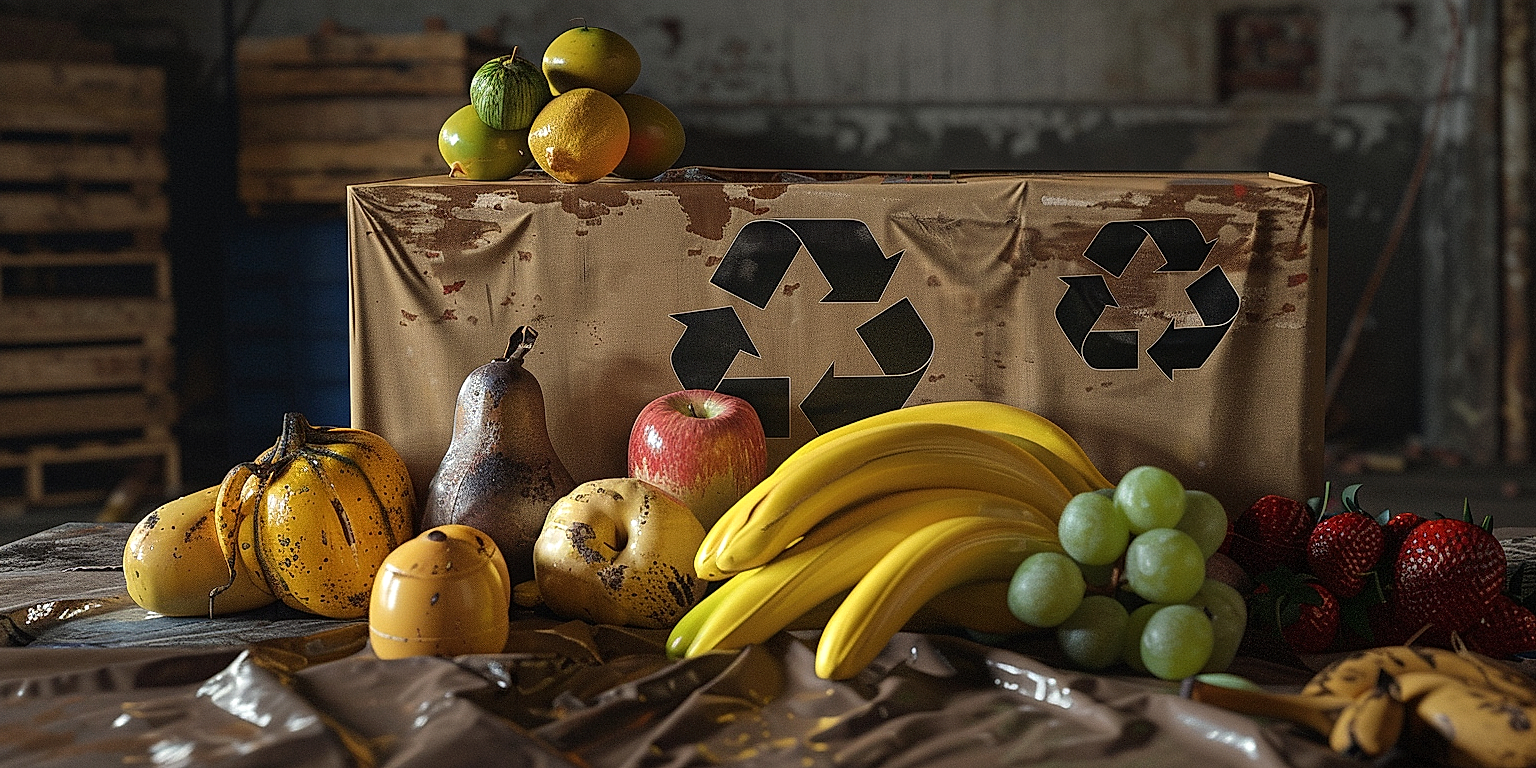The safety and integrity of our food supply chain rest on rigorous compliance with standards, especially when dealing with hazardous materials.
In the pursuit of forging a safer environment for all stakeholders, understanding and implementing best practices in handling these substances are imperative.
This discourse aims to guide those involved in the transportation of produce, where hazardous materials may be encountered.
It focuses not only on preventing accidents but also on reducing potential risks to human health and the environment.
The information presented here is based on industry standards and government regulations.
It is crucial for professionals to keep abreast of these vital aspects to ensure produce is shipped safely, efficiently, and responsibly.
Contents
- Practices For Handling Hazardous Materials In Produce Shipping
- 1. Train staff about hazardous materials handling procedures
- 2. Use Proper Protective Equipment During Handling
- 3. Pack and Seal Hazardous Goods Separately
- 4. Store Hazardous Materials in Designated Areas
- 5. Avoid Food and Hazardous Materials Cross-Contamination
- 6. Regularly Clean Equipment and Storage Areas
- 7. Dispose of Hazardous Materials Responsibly
- The Bottom Line
Practices For Handling Hazardous Materials In Produce Shipping
1. Train staff about hazardous materials handling procedures
Proper training of staff is the first critical step in the management and safe handling of hazardous materials in produce shipping.
It is essential that employees tasked with the handling of these materials comprehend the implications of mishandling.
A well-trained staff is a significant mitigation factor in the reduction of hazardous material-related incidents.
Training programs should be comprehensive, covering every aspect of handling, storage, and disposal processes.
Such programs need to be up-to-date, reflecting current best practices and adhering to industry regulations and standards.
A focused section on the identification of hazardous materials is essential as part of the training program.
Employees should be able to identify hazardous tags, symbols and labels, understanding their meanings and risks associated.
Part of the training should involve hands-on practical simulation of situations where they’d have to handle hazardous material.
By this, they acquire necessary practical skills and, importantly, the confidence to handle such materials appropriately.
The training program should also cover emergency response protocols in the event of a hazardous material spill or other related incident.
The personnel should know how to respond swiftly and adequately, minimizing damage and potential risks to human health and the environment.
Equipping your staff with this knowledge not only ensures their safety but also ascertains the safety of end consumers of your produce.
It’s not enough to train staff once; there should be regular refresher courses to keep the knowledge and skills up-to-date.
Complacent can set in over time, reducing the effectiveness of initial training thus, constant refreshers are necessary.
Similarly, it’s crucial to monitor staff to ensure they are following hazardous material handling procedures as per the training.
The safety and integrity of your produce shipping business depend heavily on how well your staff is trained and how effectively they apply their training in hazardous material management.
2. Use Proper Protective Equipment During Handling
When handling hazardous materials in produce shipping, it is crucial to use proper protective equipment.
Nonetheless, this goes beyond simply wearing gloves and a mask; it encompasses the proper use of protective clothing, eye protection, and respiratory equipment.
The demands for adequate protection could vary based on the kind of material being handled, its dangerous characteristics, the amount and the duration of exposure.
This necessitates a thorough understanding of the various kinds of protective equipment and how and when to utilize them.
For instance, heavy gloves, safety goggles or face shields, and chemical-resistant clothing may help to prevent skin and eye irritation or burns if you are dealing with corrosive materials.
On the other hand, respiratory protective equipment may be necessary when working in areas where hazardous vapors, gases, or dust are present.
Regular training and refresher courses can ensure that workers know how to correctly put on, use, and maintain these vital items of protective equipment.
Furthermore, protective equipment should always be selected based on the specific hazards of the materials you are dealing with and the potential risks involved in their handling and movement.
The provision of appropriate personal protective equipment (PPE) should never be viewed as a substitute for safe working practices or adequate engineering controls, such as good ventilation.
Regular safety audits and risk assessments can help ensure that PPE is fit for purpose and being used correctly and continuously as required.
Inspecting PPE regularly and maintaining it in a good working condition is another integral aspect of using proper protective equipment during handling.
It’s equally important to replace damaged, worn out or expired PPE to ensure that it provides the best protection possible.
Disposal of used PPE should also be done in a responsible manner, according to the guidelines provided by local regulations and the manufacturer.
To ensure safety of everyone involved, the importance of using proper protective equipment when handling hazardous materials in produce shipping cannot be overstated.
It provides employees with an additional line of defense against potential exposure to harmful substances, thus playing a central role in workplace safety.
3. Pack and Seal Hazardous Goods Separately
When handling hazardous materials for shipping, one key principle to adhere to is to pack and seal these goods separately.
In the produce shipping industry, the need for handling hazardous materials can arise due to different reasons, including pest control, the preservation of freshness, and the prevention of microbial growth which could compromise the integrity of the produce.
It is crucial to understand that these materials, if mishandled, can pose serious risks to workers, consumers, and the environment.
Therefore, implementing a robust system for packing and sealing hazardous goods separately from the rest of the produce is vital.
Separate packing helps to prevent accidental spills and leaks that could contaminate other goods or harm the staff handling them.
Goods that are packed separately are easier to identify and less likely to get mixed with non-hazardous materials
Separate sealing on the other hand, ensures that the hazardous materials are contained within a secure environment, further mitigating the risk of a spill or leak.
This also facilitates safer transportation of the goods, as the sealed packages provide a physical barrier to the hazardous content.
The entire process of packing and sealing hazardous goods should be done by trained personnel who know the proper techniques and understand the importance of proper handling.
They should also be well versed with the regulations and guidelines provided by organizations such as the Environmental Protection Agency (EPA) and the Occupational Safety and Health Administration (OSHA), that guide safe practices for hazardous materials handling.
Different types of hazardous materials might require different types of packing and sealing methods.
For instance, toxic chemicals might need to be sealed within sturdy, leak-proof containers, while radioactive materials might require lead-lined boxes.
The right packing and sealing materials and techniques can significantly reduce the risks associated with handling hazardous materials.
Moreover, proper labeling of the packed and sealed hazardous goods is also crucial.
Labels provide the necessary information about the hazards the materials pose and give clear instructions on how they should be handled.
Implementing these practices can help establish a safe work environment and maintain the credibility of your produce shipping business.
4. Store Hazardous Materials in Designated Areas
Storing hazardous materials in specific, designated areas is of crucial importance in any workplace involving produce shipping.
This practice significantly reduces the risk of accidental exposure, spillage, or any other form of unintentional contact.
Similarly, devoted storage areas for hazardous materials support in effective material inventory management.
This in itself brings about a series of benefits including easy access for workers, timely replacement or replenishment of materials, and crucially, it minimizes the probability of cross-contamination with other stored items.
These areas should not be chosen randomly but should be carefully selected, taking multiple factors into consideration.
It is essential that the designated areas are well ventilated to free any dangerous fumes that could possibly build up and cause harm.
These areas must also be secure to limit access only to trained staff and hence, prevent improper handling.
The utmost priority while designating these areas should be the safety of the workers, and any visitors the storage area may have.
Floor markings, signs, or labels should be used to clearly delineate these hazardous materials storage areas.
This aids employees in identifying them and act as a constant reminder of the safety protocols involved with their handling.
Furthermore, an effective storage system can ensure that only necessary quantities of the hazardous materials are stored at a time, minimizing potential risk.
This method not only guarantees safer handling of the hazardous materials but also helps to maintain cleaner, well-organized storage areas.
Storing hazardous materials in designated areas also protects the shipping facility, the environment, and the community at large.
Sufficient and accessible hazardous substance spill kits should be placed near these areas should any unexpected incidence occur.
Remember, it’s not just about following the guidelines, but about creating a sustainable, safe, and responsible work environment.
5. Avoid Food and Hazardous Materials Cross-Contamination
When dealing with perishable items like produce alongside hazardous materials in a shipping environment, cross-contamination is a critical concern that must be fully addressed.
In the produce shipping sector, certain hazardous materials are often transported along with food items.
Therefore, there is always a risk of cross-contamination that can adversely affect the safety and quality of the food.
To prevent this, the shippers should adopt best practices to avoid contamination between hazardous materials and food items during transit.
In a shipping environment, even a small error in handling hazardous materials can lead to large-scale contamination, causing food spoilage and posing serious risks to consumers’ health.
Separation is a vital tactic in avoiding cross-contamination.
Produce and hazardous goods should be clearly segregated in different compartments or containers during transportation.
Shippers can achieve this by adequately securing and sealing the hazardous materials, ensuring that the items don’t mix or spill over.
Practicing strict hygiene standards in the shipping environment can prevent potential contact between produce and hazardous materials.
This includes sanitizing handling equipment and ensuring that workers who are managing hazardous goods are not also handling food whenever possible.
Employing professional and well-trained staff skilled in the handling of hazardous materials also significantly decreases the risk of cross-contamination.
Another measure is consistent and thorough inspections.
Regular checks of the storage compartments and containers can detect any leaks or potential cross-contamination scenarios before they become major issues, ensuring a safe shipping environment.
Lastly, clear and precise labeling of hazardous materials can help to reduce the risk of cross-contamination.
By clearly indicating which materials are hazardous, workers can take special precautions when handling them, further minimizing the risk of cross-contamination.
Hence, adopting these best practices can ensure the avoidance of food cross-contamination with hazardous materials, ensuring the safety and wholesomeness of the food in transit, thereby maintaining consumers’ trust and satisfaction.
6. Regularly Clean Equipment and Storage Areas
Keeping equipment and storage areas clean is a fundamental aspect of managing hazardous materials in produce shipping.
Regular cleaning cuts down the risk of contamination and maintains the safety and efficiency of the entire process.
Each piece of equipment used in shipping, handling, and storing hazardous materials must be cleaned rigorously on a regular basis.
This includes mechanical equipment, such as fork lifts and conveyor belts, as well as storage containers, pallets, and even the storage facilities themselves.
Not only does this practice reduce the risks of accidents and spills, it also extends the lifespan and efficiency of the equipment itself.
Cleaning methods vary depending on the types of hazardous materials involved. However, the crucial aspect is to ensure a thorough cleaning is done under safety protocols.
Using specified cleaners and solvents, degreasing agents, or even pressurized water jets might be necessary to ensure thorough cleaning.
Particularly, cleaning areas that have been in contact with corrosive or toxic substances requires extra care and often, special cleaning agents.
It’s imperative to remember that the cleanup process itself may generate waste that must be disposed of as hazardous waste as well.
Hence, proper disposal methods for this waste must be known and followed.
Importantly, personal protective equipment (PPE) should be worn during cleaning to protect staff from potential exposure to hazardous substances.
This reinforces the importance of both proper training and protective equipment in maintaining safety in the work environment.
Furthermore, cleaning should be done systematically, with a cleaning schedule established to ensure regular maintenance.
Areas associated with the handling and storage of hazardous materials should be prioritized and given more frequent cleaning.
Lastly, it’s crucial to document cleaning activities as part of maintaining a healthy safety culture in the organization.
This provides accountability and allows for more effective monitoring of safety practices and potential areas of concern in handling hazardous materials in produce shipping.
7. Dispose of Hazardous Materials Responsibly
The disposal of hazardous materials requires a high level of responsibility and caution.
Hazardous materials, if not disposed of properly, can cause severe environmental damage and potentially pose health risks.
There are strict regulations and guidelines that need to be adhered to when disposing of hazardous materials.
Whether you are a produce shipping company or a worker in the industry, understanding these regulations is vital for the safe disposal of hazardous materials.
The legal requirements for disposal of hazardous materials are typically defined by environmental protection agencies.
These agencies set forth a number of directives to stress the importance of disposing hazardous wastes in a manner that mitigates environmental harm.
This means that when disposing of hazardous materials, companies and individuals must adhere to these specific directives and dispose of wastes at properly designed and managed disposal sites.
Disposal of hazardous materials must be meticulously documented for accountability and transparency.
Companies should consult with a hazardous waste disposal expert to ensure that they are handling and disposing of materials correctly.
By doing so, they can avoid inadvertent mishandling of materials, which can lead to legal repercussions and environmental damage.
As a rule of thumb, never dispose common trash bins or toilets. They require a special disposal process.
Employees and staff involved in the disposal of hazardous materials must be properly trained and certified.
The proper disposal of hazardous materials is a key factor in maintaining a safe and clean produce shipping environment.
This component of hazardous materials management cannot be understated, as it directly impacts a company’s reputation, staff safety, and the broader environment.
By adopting this best practice into the everyday handling and disposal of hazardous materials, produce shipping companies can help solidify their place as responsible and conscious businesses.
The Bottom Line
Ultimately, implementing safe practices in handling hazardous materials is critical in maintaining a safe business environment.
This involves comprehensive staff training, utilization of protective equipment, and adopting rigorous packaging and storage protocols.
Equal emphasis should be placed on the careful segregation of hazardous materials from edible goods to prevent cross-contamination and on regular cleaning protocols.
Lastly, environmentally responsible disposal of these substances is non-negotiable.
Upholding these guidelines ensures both human health and environmental safety.




